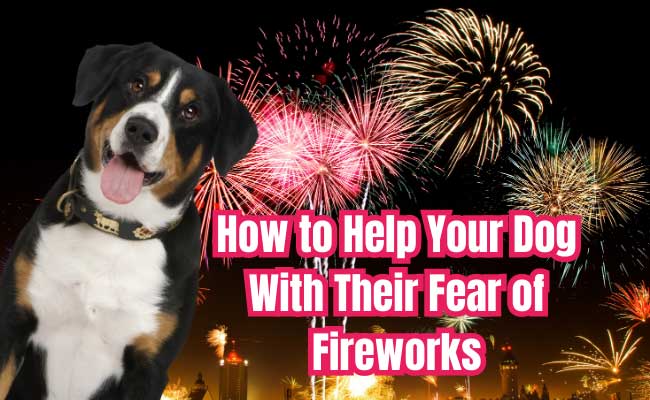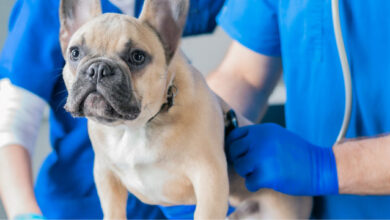
Fourth of July, New Year’s Eve, or any festive celebration often involves a stunning firework display. While we humans admire the spectacle, our furry friends often cower in fear.
You’re not alone if your dog runs and hides at the mere whiff of fireworks. Many dogs find the loud and sudden noises of fireworks terrifying. So, how can we ease their fear and ensure they feel safe?
This guide provides simple strategies to help your dog manage their fear of fireworks, turning those anxiety-filled moments into more peaceful ones. Let’s create a happier environment for our four-legged friends!
Understanding Your Dog’s Fear
Imagine a peaceful evening with your best furry friend by your side. The night sky lights up with a loud explosion of colors.
For us, it’s a thrilling spectacle, a firework display lighting up the night. But for our dogs, this can be a terrifying ordeal. Now, why is that? Let’s delve into understanding your dog’s common fears.
Fireworks through Your Dog’s Ears
First off, dogs hear differently than we do. They possess a superior sense of hearing that can pick up a wider range of frequencies, many of which are beyond human capabilities.
Those firework booms we hear are magnified for our canine friends. These unexpected, intense sounds can startle them, leading to fear and panic.
Perception of Threat
Another key aspect to consider is how dogs interpret these sounds. Unlike us, dogs lack the understanding that fireworks are harmless celebratory displays.
To them, these loud, sudden noises are unknown and potentially dangerous. Their instinct is to escape perceived threats, leading them to run or hide when fireworks go off.
Sensitivity to Change
Dogs are creatures of habit. They thrive on routine and predictability.
Fireworks are the exact opposite. The abrupt light and sound display disrupts the peaceful environment they are used to, causing distress.
The key to helping your dog deal with its fear of fireworks is understanding its experience. This empathy forms the foundation to guide them through this fear, helping them navigate fireworks events with less stress. It’s about turning a dreaded situation into a manageable one for your beloved pet.
Recognizing Signs of Fear and Anxiety in Dogs
Before addressing the fear, we must recognize signs that our dog is anxious or scared. Fear in dogs can manifest in various ways. Some dogs might overreact, making their discomfort hard to miss.
You may observe them whining, pacing restlessly around the house, or trying to hide in a secluded spot. On the other hand, some dogs may display more subtle signs. You might notice they’re yawning more than usual, excessively licking their lips, or refusing to eat their favorite treat.
In addition to these signs, your dog might be shaking or trembling, panting or drooling, or barking or howling more than usual. Noticing and understanding these behaviors are essential. It can help you intervene and start taking steps to soothe their anxiety.
Creating a Safe Space for Your Dog
One practical approach to help your anxious pet is creating a ‘safe space’ for them. This space is a sanctuary for your dog, where they can retreat when scared or overwhelmed. This idea is based on dogs’ instinct to seek shelter when frightened.
The safe space can be a specific room in your house, a crate if your dog is crate trained or even a quiet corner. The space should be filled with their favorite things – a comfy bed, familiar blankets, cherished toys, and treats. These items can bring comfort and create positive associations with the safe space.
Remember to introduce this space to your dog when there are no fireworks, allowing them to spend time there and get comfortable. Encourage them gently to use this space, but don’t force them; this could create further stress.
Over time, this safe haven can provide immense relief to your dog during those scary fireworks moments.
Using an Anxiety Pet Comfort for Dogs
Let’s face it, watching your furry friend in distress during firework displays can be heart-wrenching. You’ve tried treats, toys, and a quiet room, but the fear persists.
What else can you do to help? Enter the world of anxiety wrap for dogs, a simple yet powerful tool to help your dog manage their fear of fireworks.
The Magic of Gentle Pressure
Anxiety wraps are designed to apply gentle, continuous pressure on your dog’s body. This sensation mimics the comfort and security of being held closely or cuddled. Remember how a scared child calms down when hugged?
Anxiety similarly wraps work. They make your dog feel safe and secure amidst the loud chaos of fireworks.
Introducing the Anxiety Wrap
Introducing the anxiety wrap to your dog during calm moments, well before the fireworks begin, is essential. Start by letting them wear the wrap during their favorite activities, like during meal times or while playing fetch. This way, your dog starts associating the wrap with positive experiences.
Timing it Right
When fireworks are anticipated, put on the wrap a few hours beforehand. This helps prepare your dog for the stressful situation ahead. They will already be in a state of comfort when the loud noises begin.
Incorporating an anxiety wrap into a pet care routine can make a difference. It’s about providing a source of comfort to help your beloved pet navigate through the frightening experience of fireworks.
Remember, every step you take towards understanding and catering to your dog’s needs contributes to its happiness and well-being.
Incorporating Desensitization and Counter-Conditioning Techniques
When it comes to helping your dog overcome their fear of fireworks, you can employ two super-effective techniques: desensitization and counter-conditioning. These may sound technical, but they are simple to understand and apply.
Desensitization
The core idea behind desensitization is slow, gentle exposure to the scary thing – in this case, the noise of fireworks. It’s like dipping your toes into a pool before diving in.
You can start by playing firework sounds at a low volume so it’s barely audible. Over time, and as your dog grows comfortable, you can gradually increase the volume. This way, your dog gets used to the sounds without getting overwhelmed.
Counter-Conditioning
Counter-conditioning is about changing your dog’s perception of fireworks from negative to positive.
Here’s how you do it: whenever you play the firework sounds (while practicing desensitization), provide your dog with something they love.
It could be their favorite treat, a belly rub, or a round of their preferred game. The aim is to associate the firework noise with happy, positive experiences, thereby changing your dog’s response.
A Powerful Duo
When used together, desensitization and counter-conditioning can be a game-changer. They help your dog slowly but surely overcome their fear of fireworks.
Remember, the key here is patience. It might take time, but the payoff—seeing your dog calm and content during a fireworks display—is well worth the effort. A future where the Fourth of July is fun for you and your dog is certainly within reach!
Consultation With a Veterinarian or Professional Dog Trainer
Despite your best efforts, is your dog still paralyzed with fear during fireworks? Does their anxiety seem to be worsening over time? Don’t worry, you’re not alone, and there’s further help available.
Sometimes, it’s best to seek professional assistance. Let’s discuss how a consultation with a veterinarian or professional dog trainer can aid in managing your dog’s fear of fireworks.
Veterinarian
It’s essential to rule out any underlying pet health issues that could exacerbate your dog’s fear. Dogs might often exhibit heightened sensitivity due to physical discomfort. A veterinarian can help identify if there’s a health-related concern, potentially offering solutions to alleviate your dog’s discomfort.
Dog Trainers
Professional dog trainers specialize in understanding dog behavior. They can provide valuable insights into why your dog reacts a sure way to fireworks and offer effective strategies to manage their fear. They can also guide you through training techniques, such as desensitization and counter-conditioning, which can prove beneficial for your dog.
Remember, seeking help doesn’t mean you’ve failed your pet. Instead, it shows dedication to ensuring your dog’s comfort and well-being. It’s about gathering all the resources you can to help your furry friend navigate their fear of fireworks.
Understanding Your Pet’s Fear of Fireworks
Helping your dog overcome their fear of fireworks is a journey of understanding, patience, and gentle guidance. Incorporate techniques like desensitization and counter-conditioning.
Utilize tools such as anxiety wraps. And seek professional advice when needed. You can then significantly ease your dog’s firework anxiety.
Every small step you take matters, making a difference in your furry friend’s life. So your dog can feel safe and secure next time the fireworks light up the sky.
Please keep visiting our page for more insights on caring for your beloved pet. Remember, a happier dog leads to a more comfortable home!



